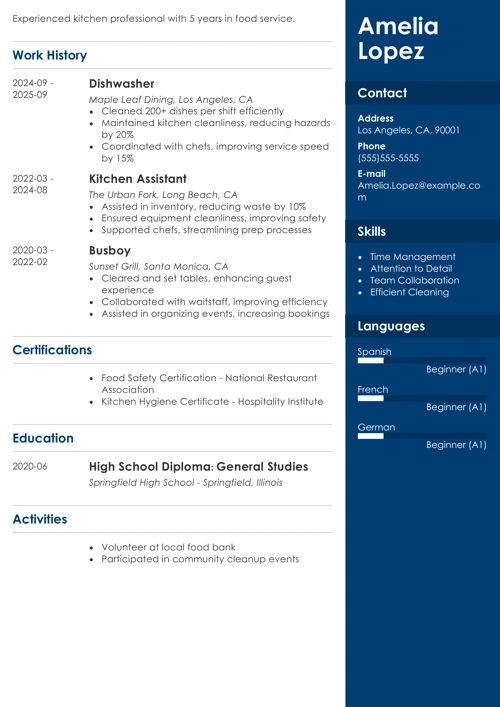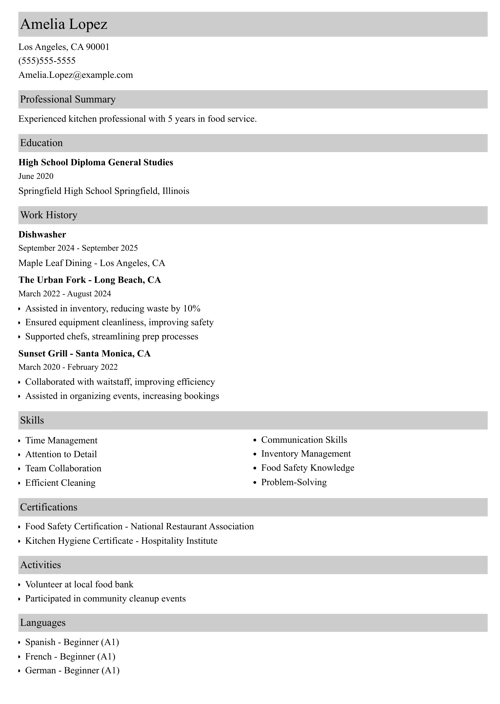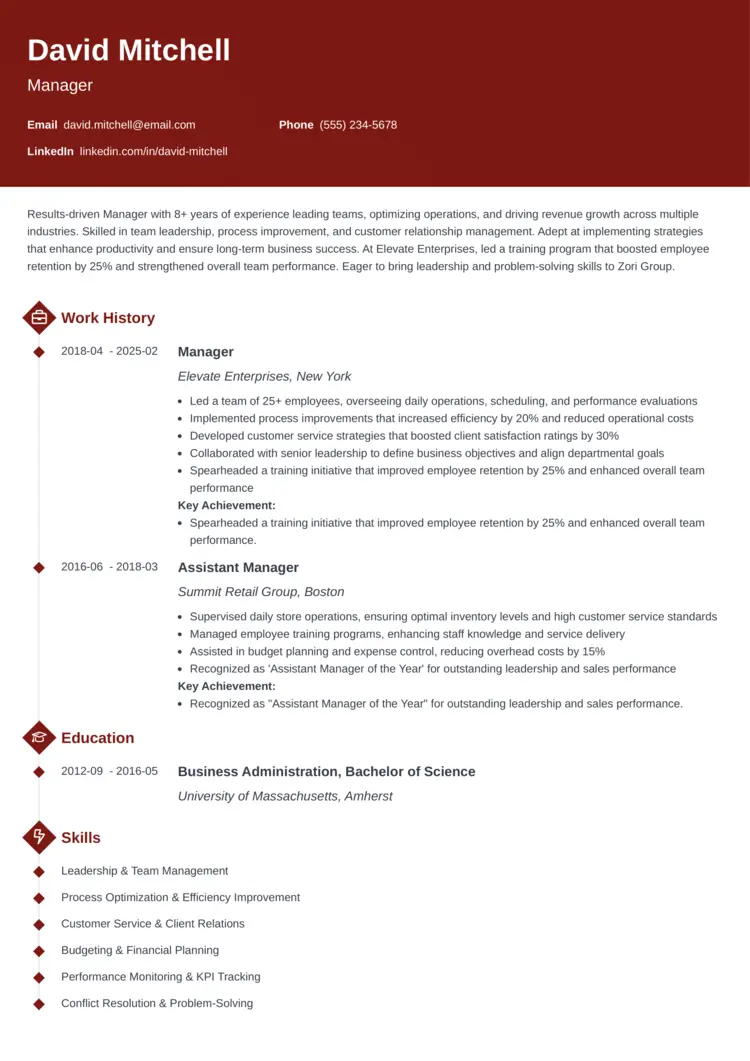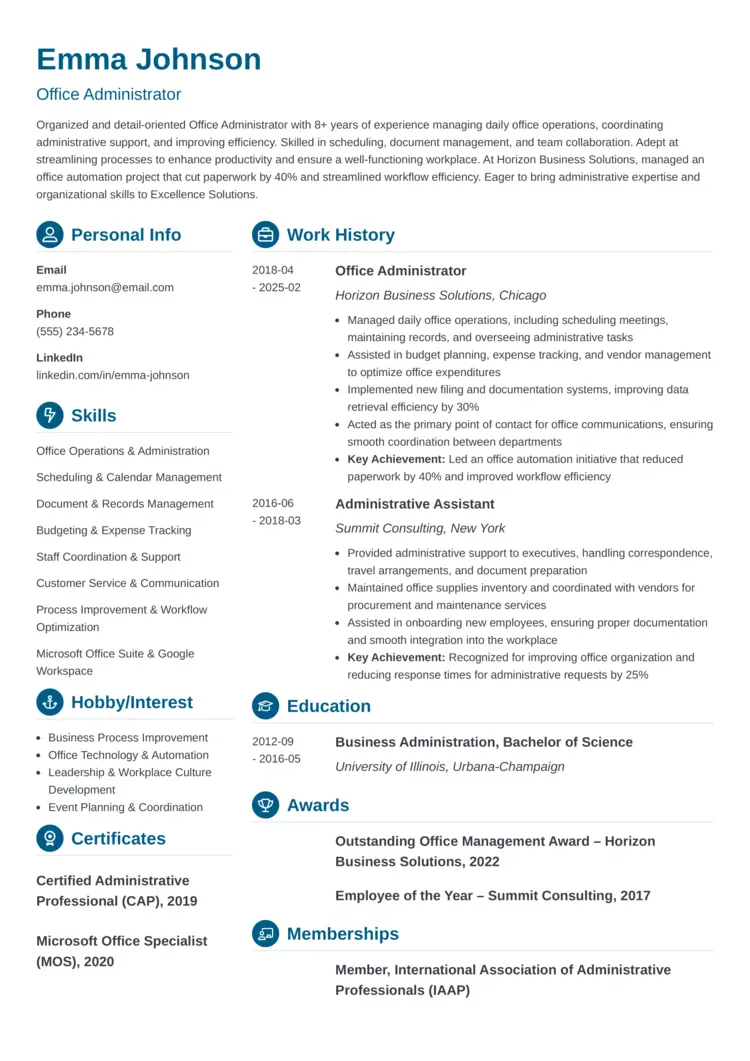You’re ready to start applying to jobs, but there’s something in your way. You’re stuck wondering, “What does a professional resume look like?” Know that you’re not alone. Whether you're applying for your first job or just updating your old resume, it's normal to be unsure.
A resume is your first chance to show a company who you are and what you can do—but figuring out what to include and how it should look can feel frustrating.
In this guide, you'll see real examples, learn what makes a good resume, and get tips to help yours stand out. Let's make your resume look great and get you one step closer to the job you want.
Want to save time and have your resume ready in 5 minutes? Try our AI resume builder. It’s fast and easy to use. Plus, you’ll get ready-made content to add with one click. See 20+ resume templates and create your resume here.
Sample resume made with our builder—See more resume examples here.
What Should a Resume Look Like: Formatting & Layout Tips
Creating a professional-looking resume starts with three things: readability, relevance, and clean design. It’s also important to keep applicant tracking systems (ATS) in mind. These software tools scan your resume before a recruiter ever sees it.
Most companies use ATS to filter resumes based on keywords and information that match the job description. Resumes that are simple, well-organized, and free of heavy design tend to perform best.
Let’s go over the best formatting and layout tips to help your resume pass ATS scans and reach the recruiter.
Choose a template that fits your industry
When you’re asking, “How should a resume look?” remember that the resume template you choose should match the field you’re in.
For traditional industries like law, finance, or accounting, stick to a classic, minimal design. For creative fields like marketing, design, or film, you can use a more bold or visually striking template—while still keeping it professional and easy to read.
Start with a clear resume header
At the very top of your resume, include a header with the following contact details:
- Full name
- Phone number
- Professional email address
- City and state
- LinkedIn profile or portfolio link, if applicable
Make sure your name stands out by using a slightly larger font size. Keep the rest of your resume header simple and easy to read—this is how employers will contact you, so accuracy and clarity matter.
Use standard section headers
Label each part of your resume with professional headers like “Work Experience,” “Education,” or “Skills.” These help both ATS and recruiters find what they’re looking for quickly. Keep your headers simple and consistent throughout the document.
Pick easy-to-read fonts
Stick to professional fonts like Arial, Calibri, or Times New Roman in 10–12 point size. These fonts are easy to scan and ATS-friendly. Avoid script or decorative fonts—they may look fun, but they can be hard to read and won’t always display correctly.
Make good use of white space
Don’t crowd the page. Use line spacing of 1.0 to 1.15 to keep text readable without wasting space. Leave a bit more space, about 1.5 lines, between sections to help guide the reader’s eye.
Set your margins between 0.5 and 1 inch on all sides. This keeps everything neat while leaving enough room for key information. Good white space not only makes your resume easier to read but also gives it a clean, modern look.
Keep formatting consistent
Consistency matters. Use the same bullet point style, date format, and font size throughout. If you bold one job title, bold them all. Clean formatting shows attention to detail—an essential skill in almost any job.
Avoid these common mistakes
To keep your resume ATS-friendly, skip headshots, photos, colorful borders, or personal information, such as your full address or date of birth. These can clutter your resume and may not align with standard hiring practices. Also, avoid using tables or text boxes, as these can confuse ATS.
Examples of What a Resume Should Look Like
These professional resume examples follow all the tips discussed above. Use them as your guide when creating your resume.
Manager resume example
The design features bold headers, clear sections, and plenty of white space, ideal for scanning by both ATS and recruiters.
Sales associate resume example
The resume utilizes standard fonts and bold colors that help guide the reader’s eye to key sections, such as work experience and education.
Office administrator resume example
The resume’s uncluttered presentation breaks down complex administrative roles into digestible parts, enhancing readability and ensuring consistency.
Making a resume with our builder is incredibly simple. Follow our step-by-step guide, use ready-made content tailored to your job and have a resume ready in minutes.
When you’re done, our AI resume builder will score your resume and our resume scanner will show you exactly how to improve it.
Content Best Practices
Now that your resume layout is in good shape, it's time to focus on what really counts: the content.
After all, your resume isn't just about design; it's also about what you say and how clearly you say it.
Tailor your resume to the job
Make sure everything on your resume matches the requirements of the role you want. Read the job ad carefully and look for qualifications that appear consistently. Focus on matching your experience and skills to keywords from the job description. This helps you get past ATS and shows the hiring manager you’re a great fit.
Lead with your strengths
Start with a short resume summary at the top that highlights your top skills, greatest achievements, and what you bring to the table. This section should give the hiring manager a quick snapshot of why you're a strong candidate
Focus on your most relevant strengths and tailor this section to match the job description. Avoid generic statements—be specific and confident.
For example:
"Detail-oriented marketing specialist with over three years of experience in social media strategy and content creation. Increased engagement by 40% through targeted campaigns. Strong communicator with a passion for creative storytelling."
Focus on achievements, not just duties
Go beyond listing what you have to do in your job; show what you actually accomplished. Use numbers, results, or specific outcomes when possible, like “Improved customer satisfaction scores by 30%” or “Trained five new employees.” These measurable achievements demonstrate to employers that you can apply your skills to real workplace situations and deliver results.
Show a balanced skill set
When creating your skills section, include a mix of hard skills (e.g., software, tools, or job-specific abilities) and soft skills (e.g., teamwork, time management, or communication). This helps employers see that you’re not only qualified but also someone who can work well with others and adapt.
Keep it to one page (if you can)
If you have less than 10 years of experience, aim to create a one-page resume. Hiring managers often skim resumes quickly, so the shorter and more focused it is, the better. Prioritize your most relevant experience and cut any details that don’t support your fit for the job. Use formatting wisely to maximize the space without overcrowding the page.
Double-check for errors
Spelling and grammar mistakes can hurt your chances, even if you’re highly qualified. Proofread your resume carefully, and if possible, ask someone else to review it too. A clean, error-free resume shows professionalism and attention to detail.
Key Takeaways
- A resume should be clean, simple, and easy to read. Avoid fancy designs or crowded layouts.
- Use a professional template with clear headers and plenty of white space. This helps both recruiters and ATS read your resume.
- Start with a strong summary at the top. Use it to highlight your top skills and most significant achievements.
- Only include information that is relevant to the job. Leave out unrelated jobs or extra details.
- Focus on what you achieved, not just what you did. Numbers and results help show your impact.
- Keep your resume to one page if possible. Short and focused resumes are easier to read and more effective.
About Zety’s Editorial Process
This article has been reviewed by our editorial team to make sure it follows Zety's editorial guidelines. We’re committed to sharing our expertise and giving you trustworthy career advice tailored to your needs. High-quality content is what brings over 40 million readers to our site every year. But we don't stop there. Our team conducts original research to understand the job market better, and we pride ourselves on being quoted by top universities and prime media outlets from around the world.






